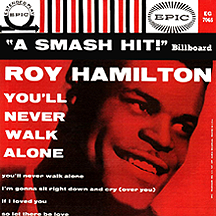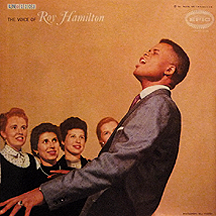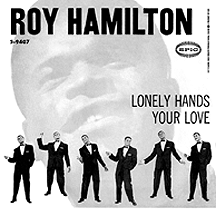ROY HAMILTON
I became familiar with Roy Hamilton through his hit single "Don't Let Go," arguably one of the greatest records ever made. His vocals, the energy, the brilliance of production instantly grabbed me at an early age. Later, when I heard the song in stereo for the first time...even better! I wanted to know more about this artist and find out if he had other "Don't Let Go"-type songs. He did, and as it turns out, possessed much more than that. His style influenced many vocalists who came later, but his life, though eventful and successful, was a short one.
Born in 1929 in Leesburg, Georgia, Hamilton's main exposure to music as a youngster came from church gospel choirs. In his early teens, his family moved to Jersey City, New Jersey, where Roy eventually followed three different paths of interest: he was athletic in school, which led to a stint as a heavyweight Golden Gloves boxer, and briefly studied commercial art, but had a more passionate interest in singing. Classical and operatic voice training followed, and by the time Roy was 18 he had joined a gospel quartet, The Searchlight Singers. In 1947, like many before and after him, he gained a spot in the amateur talent show at New York's famed Apollo Theater. His performance of "You'll Never Walk Alone" from the highly successful 1945 Richard Rodgers-Oscar Hammerstein Broadway musical Carousel resulted in a first place showing. A singing career was now within the realm of possibility.
It wasn't that easy, though. For the next few years, the Apollo win was his only claim to fame, as he experienced firsthand the challenges of breaking into the music business. Roy managed to get some club dates here and there, building more consistency both as a singer and in promoting himself, when in 1953 local New Jersey disc jockey Bill Cook caught his act and susequently became his manager. About this time, Columbia Records had decided to launch a new label, Epic, for the purpose of promoting rhythm and blues, jazz and fledgling pop acts in niche markets and ultimately into the mainstream. They saw Hamilton as a potential for pop/rhythm and blues crossover appeal. He was one of the first artists signed, and success came quickly. Reaching back into his bag of tricks, "You'll Never Walk Alone" was his first release, quickly becoming a number one R&B hit in early 1954. Suddenly Roy Hamilton was everywhere, and not only the public, but aspiring singers far and wide took notice of Hamilton's rich, dynamic baritone sound.
A two-year run of continuous hits followed. "If I Loved You," another Rodgers and Hammerstein Carousel classic, received the same treatment as the previous smash and became his second big hit. Next up was the Robert Maxwell-Carl Stigman tune "Ebb Tide," a major instrumental hit in 1953 by Frank Chacksfield. A year later, Roy's vocal rendering scored. The singer had zeroed in on a lucrative and artistically satisfying cross between pop and rhythm and blues.
In 1955, Hamilton became a key early contributor to the legend of one of the past century's most popular standards, "Unchained Melody." Written by Alex North and Hy Zaret for the low budget prison film Unchained and sung on the soundtrack by Todd Duncan, the song blasted onto the charts that spring with three versions that all made the top ten of the pop charts, Les Baxter with his orchestra and chorus having the biggest of these, competing with a compelling jazz-styled version by Al Hibbler, and Hamilton's take on the song, which achieved the bonus of reaching number one on the R&B charts. This was the last occurrence to date of three different versions of the same song occupying positions in the U.S. top ten simultaneously. The song has since been recorded by hundreds of artists, including The Righteous Brothers in 1965, and is one of the most-performed compositions of the 20th century.
Hits kept coming, including "Forgive This Fool" and "Everybody's Got a Home," but by 1956 the rigors of success had taken a toll on Hamilton. He fell ill and decided to take a break from the business, citing exhaustion as his reason for this self-imposed reitrement. Over the next couple of years, rock and roll began to transform listeners' tastes, and Roy was suddenly challenged when he decided to resume his career toward the end of 1957. He adapted with a newly-energized style and made an immediate impact with "Don't Let Go" in early '58, written and arranged by former Atlantic Records R&B trailblazer Jesse Stone. Roy's vocal performance on the gospel-tinged recording had an urgency missing from his earlier efforts ('one day baby you'll quit me yet, I'll be crying and soaking wet'), and for the first time in his career he crossed over between R&B and rock instead of R&B and pop.
The "new" Roy Hamilton appeared in the 1958 film Let's Rock! He established himself visually as a rockin' player with a hot studio-staged performance of "Here Comes Love." A variety of releases followed in 1958 and '59, ranging from rhythm to rock, teen and gospel, including "I Need Your Lovin'" and Neil Sedaka and Howard Greenfield's "Time Marches On." In 1961, Roy had one of his finest moments, a gospel rave-up that became his last major hit. "You Can Have Her" had it all, Roy's unfettered vocals, strong uptempo backup, an anguished delivery and some wailin' near the end that would surely bring the roof down at a live performance. Despite this success, in 1962 Epic Records passed on renewing his contract. Other major labels lined up to sign him, but subsequent releases on MGM, RCA Victor and Capitol failed to connect.
Whether his earlier illness can be connected to his physical condition at the end of the 1960s is anyone's guess. In July 1969, living at that time in New Rochelle, New York, Roy Hamilton, just 40 years old, suffered a stroke and died. He'd built a strong catalog of recordings, influenced and inspired many up-and-coming singers, and left a legacy to be treasured far beyond his brief lifespan.
NOTABLE SINGLES:
- You'll Never Walk Alone - 1954
- If I Loved You - 1954
- Ebb Tide - 1954
- Hurt - 1955
- Unchained Melody - 1955
- Forgive This Fool - 1955
- Without a Song - 1955
- Everybody's Got a Home - 1956
- Don't Let Go - 1958
- Pledging My Love - 1958
- I Need Your Lovin' - 1959
- Time Marches On - 1959
- You Can Have Her - 1961
- You're Gonna Need Magic - 1961
- Let Go - 1963




